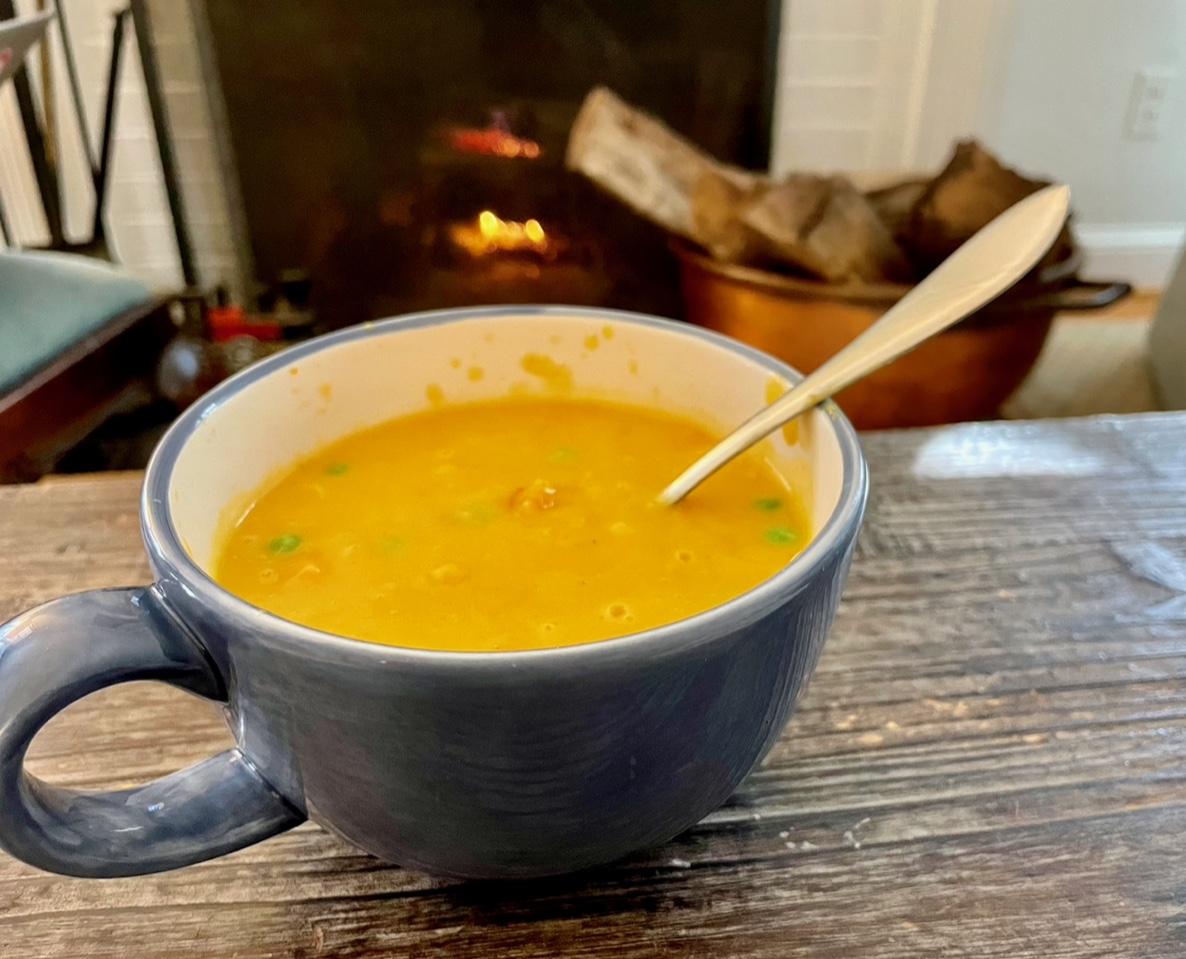When November arrived wearing shorts and flip-flops, I was lulled into believing that winter was still weeks away, and that I didn’t need to bring in the porch plants or shut off the hose bib. But then, just a couple of days ago, Buffalo was buried under several feet of lake-effect snow, Notre Dame and Boston College played football in a blizzard, and on a recent frosty morning, the very first thing I did upon waking was build a fire in the fireplace. Suddenly, it’s cold again.
The second thing I did that same morning was make soup: butternut squash soup with a liberal sprinkling of curry powder and some frozen peas and carrots. Chili and corn bread make a delicious winter dish and so does beef stew, but what’s more filling and better for you on a cold day than a big bowl of hot soup? Tomato bisque, clam chowder, chicken noodle, consommé; a steaming mug of soup is just what the doctor ordered. Fuel for the belly and, as any Jewish mother will remind you, good for the soul.
Soup has been around a long time. Our cave ancestors figured out how to boil water with hot rocks, and that plants or nuts tasted a lot better when liquified in it. In the 16th Century, street vendors in Paris sold a highly concentrated but inexpensive concoction they called ‘restaurant’ (meaning “something restoring”) and touted it as an antidote to physical exhaustion. A couple hundred years later, an enterprising Parisian opened a shop specializing in these steaming bowls and suddenly the word ‘restaurant’ had a more expansive meaning: any establishment devoted to eating. Thank you, soup!
Over on this side of the ocean, the first colonial cookbook, published in Williamsburg, Virginia, in 1745, contained several recipes for soup. Some thirty years later, another cookbook called “The Frugal Housewife” devoted an entire chapter to the savory subject of soup. In the 19th Century, waves of European immigrants arrived on these shores, bringing with them all manner of new recipes for hearty soups, just what we all needed to build a new country.
The soup market boomed in the late 19th Century with the invention of canning. Suddenly making soup was easy, and almost overnight, it became a commercial success. In 1897, Mr. Campbell introduced Americans to a condensed version of his tangy tomato soup and today, that rich, red treat is still America’s favorite. Second and third prize go to Campbell’s Cream of Mushroom and Chicken Noodle; last year, we devoured about 2.5 billion bowls of those three alone!
Now, soup has its own international alphabet that runs the gamut from Aguadito, a Peruvian green soup that includes peas, carrots, cilantro and bites of chicken which is reputedly a good cure for a hangover, to Zurek, a Polish sour rye soup made with sausages, traditionally served in bowls made of bread. In between, there is bouillabaisse and borscht; gazpacho, goulash, and gumbo; spicy Vietnamese Phö and Philadelphia Pepper Pot, made with tripe. There are national specialties like Cock-a-leekie soup from Scotland, as well as regional delicacies like our very own Cream of Crab Soup, liberally seasoned, of course, with Old Bay. There are concoctions with exotic names like Bird’s Nest Soup, Egg Drop Soup, or Mulligatawny. The list goes on…
Yesterday, the grandkids came over for an after-school visit so I decided to conduct a little market research. “What’s your favorite soup?” I asked. They didn’t hesitate. “Maryland Crab with big lumps of crab meat” they all shouted—after all, they’re Marylanders. My wife was in the room helping the kids write letters to Santa, but I didn’t need to ask her; she can’t resist French Onion Soup with extra cheese. Me? I thought about stopping at the letter V for vichyssoise, a cold puree of potatoes, leeks, and cream, invented by a French chef at the Hotel Ritz in New York, but that’s a summertime favorite, out of season today.
But first things first. I went out to fetch some logs from the wood pile and rebuilt the fire in the hearth. Then I began to simmer a pot one of my favorite winter soups: Chippewa Soup, a redolent and creamy blend of tomato and pea soups, slightly curried and flavored with bay leaves, a smoked ham bone and some sautéed vegetables, strained away before serving. I’ll serve it with seasoned croutons, a hint of sherry, and a dollop of sour cream. Bon appetit!
I’ll be right back.
Jamie Kirkpatrick is a writer and photographer who lives in Chestertown. His work has appeared in the Washington Post, the Baltimore Sun, the Philadelphia Inquirer, the Pittsburgh Post-Gazette, the Washington College Alumni Magazine, and American Cowboy Magazine. Two collections of his essays (“Musing Right Along” and “I’ll Be Right Back”) are available on Amazon. Jamie’s website is www.musingjamie.net.




Beryl Smith says
Wow! Would I love some of those recipes.
Jamie Kirkpatrick says
Glad you asked! Here’s my recipe for Chippewa Soup:
Combine two cans of tomato and split pea soup.
(Campbell’s is just fine.) Add a smoked ham hock. In a separate pan (I prefer a cast iron skillet), dice and sauté in half stick of butter, carrots, celery, and onion. Add curry powder to taste-the more, the better in my book-and cook for 5 minutes. Add the curried vegetables to the soup and let it simmer on the stove for two hours before draining the soup through a colander. Mix in enough heavy cream to turn the color to gold. Garnish with fresh chives, a crouton or two, and a dollop of sour cream. Serve hot or cold…but hot is better!